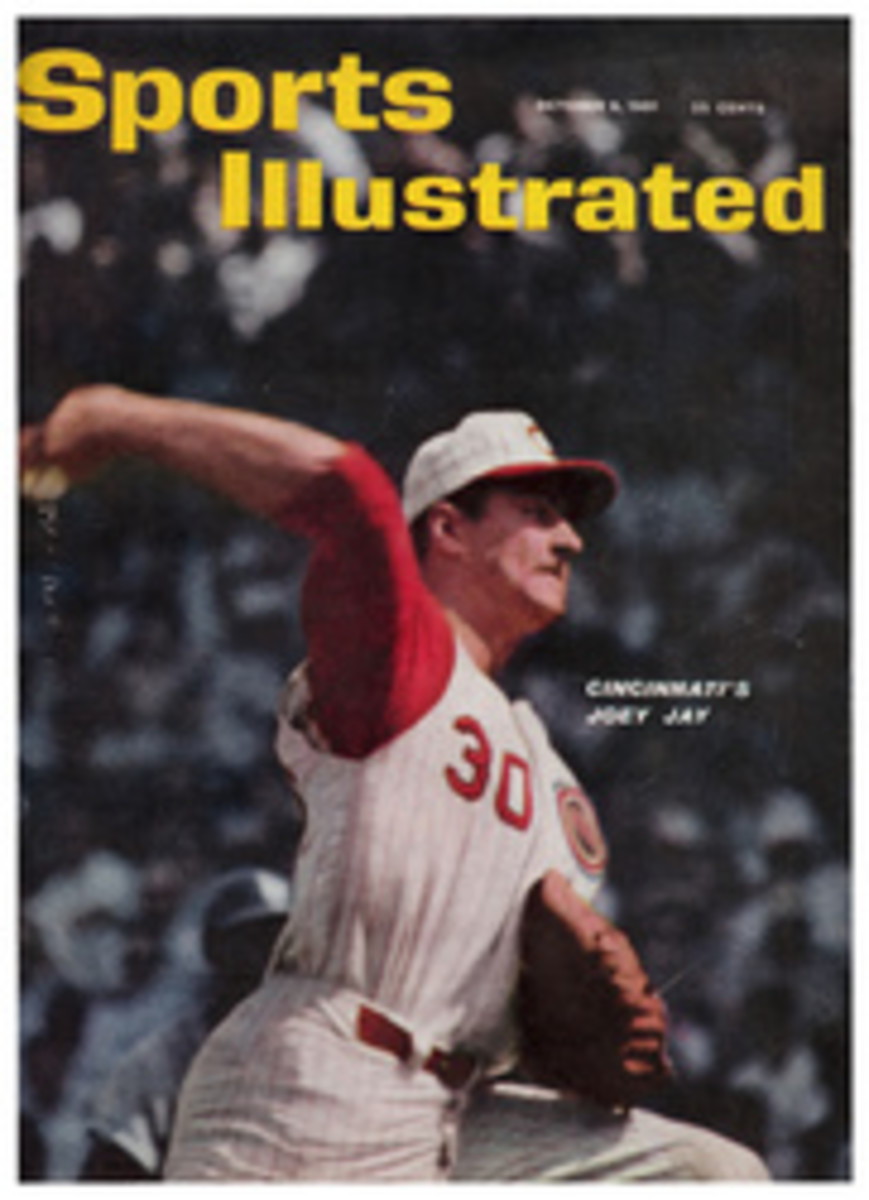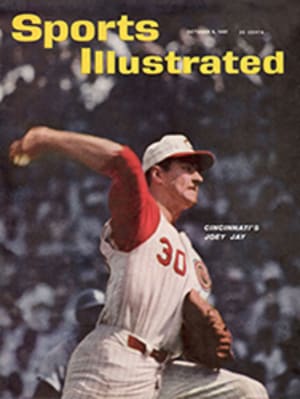
HOPE REVIVES IN SOUTH BEND
There was a pep rally in South Bend on Friday night that began in bedlam and proceeded directly to hysteria, where it remained for several hours. On Saturday the Notre Dame Golden Dome, freshly gilded, flashed back the rays of the autumn sun until Our Lady danced in the air like some celestial vision. On the cover of the game program, wearing his old magical, twisted grin, was Knute Rockne, back to haunt Notre Dame opponents once again. The only thing missing was George Gipp.
After the band swung into the most famous college fight song ever written, and 55,000 people swallowed the lumps in their throats long enough to shake down the thunder from the sky, Oklahoma didn't have a chance. Notre Dame won the ball game 19-6, and if the luck of the Irish hadn't called a brief time out, figuring perhaps that it had accomplished enough for one day, the score could have gone much higher.
A 165-pound halfback from Donora, Pa., Angelo Dabiero, ran through Oklahoma like a berserk water bug and a 200-pound junior fullback from Chicago named Mike Lind spread havoc in Dabiero's wake, but the Oklahomans, although frequently close to destruction, retained enough presence of mind to recover two Irish fumbles and intercept two passes. Notre Dame also lost a touchdown when Quarterback Daryle Lamonica's 15-yard scoring run in the fourth quarter was called back, and the Irish sophomores played like sophomores to blow a final chance.
The Irish had no passing attack worth mentioning—Lamonica and sophomore Frank Budka completed only three of eight attempts for 25 relatively useless yards—but Notre Dame didn't really need passes. It had Dabiero and Lind and that big line. Dabiero, a sandy-haired little assassin with a snaggle-tooth grin, led Notre Dame ball carriers in the disastrous 1960 season with 325 yards. He is well on the way to matching that total after one game. Dabiero raced through Oklahoma on his weaving runs for 176 yards in 11 carries, and one of these went 51 yards for his team's first touchdown. Lind scored twice, once from 23 yards out, again from the two, and he gained 121 yards in 18 tries. In all, Notre Dame gained 367 yards on the ground. Oklahoma had 125.
For much of the first half, the big crowd and a national audience watching ABC's weekly television effort saw a tight game. A good sophomore quarterback named Bill Van Burkleo, after limping for three weeks on an ankle injured in an early Oklahoma scrimmage, took over the ball club and led the Sooners down to Notre Dame's 10 late in the second quarter. There a penalty pushed Oklahoma back five yards, and Karl Milstead's field goal try was blocked.
From its own 41, Notre Dame scored in two plays. Lind went over left tackle for eight yards (Notre Dame picked on the left side most of the day), then Dabiero, taking a hand-off from Lamonica, swung around left end, faked a couple of Oklahoma tacklers onto their noseguards and cut loose on his long touchdown run.
Oklahoma came back almost immediately on a rather unusual maneuver. Joe Perkowski's kickoff—into a wind that sometimes came gusting over the stadium wall at 45 miles an hour—hung in the air so long that the Notre Dame tacklers ran past it. Gary Wylie, fielding the ball for Oklahoma on the 25, found hardly anyone in front of him and lumbered 47 yards to the Irish 28 before Frank Minik finally came scooting across to bang him out of bounds. Van Burkleo sent the Sooners on down to the six in six plays, and Jackie Cowan took a pitchout around right end from there. Milstead's kick was wide to the right, and Oklahoma was never to get closer than the Notre Dame 26 again.
The second Irish drive went 74 yards in seven plays. Dabiero ran for seven and 21, Lind for 21 more in three tries. Then, from the Oklahoma 23, Lamonica faked to Dabiero going right, and 10 Oklahoma defenders went that way, too. So Lamonica handed the ball off behind his back to Lind, who was proceeding toward left tackle. As it turned out, only the Oklahoma safety man, Mike McClellan, remained in Lind's way, but Les Traver went across from his end position to throw a block and that removed McClellan. Lind stepped neatly around the two bodies to score. Perkowski's kick was good.
Notre Dame's final touchdown drive covered 62 yards, very quickly. Dabiero contributed runs of 22 and 30 yards, while Lind got the rest by smashing for eight and two.
"We feel," said Notre Dame Coach Joe Kuharich, "that the men handled their offensive assignments well. Dabiero seems to have matured."
'Twas a famous victory
It was a good victory, even over an Oklahoma team that had its second unit decimated by injuries in the weeks of practice leading up to the opener and was therefore ill equipped to cope with Notre Dame's superior size and depth in the second half. And it was a victory that set Notre Dame fans from Puget Sound to Omsk talking about the return to the days of Rockne and Frank Leahy which, of course, is what Notre Dame fans talk about after every winning game. But they should be cautioned about raising their hopes too high.
For one thing, it was a disservice to Oklahoma to call this year's Sooners a "comeback team." Perhaps they will come back from last year's 3-6-1 record, the worst at Norman in 37 years, but what Oklahomans have learned to call a good season is still a schedule or two away. The residue of several cautious recruiting years, when the Sooners were under NCAA probation, remains to plague Coach Bud Wilkinson. It is to the sophomores and freshmen of 1961 that Oklahoma must look, and this can be a pleasant view. Although sophomores made up most of the injury-riddled second team on Saturday, the same sophomores were undefeated as freshmen a year ago and will return for two more seasons, much healthier, it is hoped. As for the members of this year's freshman crop, five days after reporting for practice they scored four touchdowns against the varsity in a scrimmage.
Another factor for Irish fans to consider is the season that lies ahead. Notre Dame must yet face Purdue, Southern Cal, Michigan State, Northwestern, Navy, Pittsburgh, Syracuse, Iowa and Duke, a representative schedule for the Chicago Bears. And, finally, Joe Kuharich has nothing, really, with which to match the teams that went through five undefeated seasons for Leahy, winning three national championships for that controversial genius in the postwar years.
Fables and the fabled
In the Leahy days, Notre Dame had a seemingly endless supply of passers who could throw a football through the nickel slot on a parking meter at 30 yards and linemen capable of throwing opposing ball carriers with equal accuracy for only slightly shorter distances. Irish halfbacks came equipped with wings and the fullbacks ran over people without even noticing a bump. Some of the names frighten you even today: Johnny Lujack, Emil Sitko, George Connor, Jim Martin, Bill Fischer, Terry Brennan, Ziggy Czarobski and Marty Wendell, all of the 1947 team; Leon Hart, Bob Toneff, Jim Mutscheller, Jerry Groom, Bob Williams, Frank Tripucka, Ralph Guglielmi, Johnny Lattner, Paul Hornung, Al Ecuyer, Nick Pietrosante, Menil Mavraides, Frank Varrichione, Don Schaefer, Pat Bisceglia, Dick Lynch, just to mention a few dozen. Some of these later played for Brennan, but they were recruited under the Leahy regime, and Kuharich can be pardoned for wishing that a few had been left over for him, too.
Strangely enough, however, Kuharich is under little or no pressure, win or lose—which is not what one hears on the street corners outside of South Bend. There exists in America a great deal of misinformation about Notre Dame. Part of it stems from alumni who attended Waterford Normal or South Georgia T&T or P.S. 61 and have never been within 500 miles of the Golden Dome. They are Notre Dame alumni, nevertheless, and they are happy to tell you what they think. What they think is that Notre Dame has to win. Look at what happened to Terry Brennan.
Today everyone on the Notre Dame campus loves Terry Brennan. He was a wonderful young man, intelligent, trustworthy, loyal, etc. The only trouble, they will tell you in retrospect, is that maybe he wasn't a very good coach. And some people defend even his coaching skills. "It could have happened to anybody," says Moose Krause, the athletic director. "Terry came in after Leahy's great years and there had to be a letdown. Why, even Rockne had a bad year in '28 and Leahy had one in 1950. Terry just got caught in the cycle."
"Naturally, we would like to have a winning football team," says the Rev. Edmund P. Joyce, executive vice-president of the university and chairman of the faculty board in control of athletics, "but it is not so important as all that. I can understand the attention the football team has received, because of its record in the past, but you must remember that Notre Dame is a great academic institution and it has been for many years. If boys on the football team develop well, do good work in class, keep the game in its proper perspective as part of campus life and also win, that is wonderful. But if they lose, yet answer those other requirements, then we can hardly be disappointed.
"Alumni?" asks Father Joyce. "They remain interested but they allow us to run the school."
Kuharich, although he is not much of a hand with excuses, has plenty available to explain his two less-than-sensational seasons at Notre Dame in which the Irish lost more games (13) than Rockne's teams lost in 13 years or Leahy's in 11. The main problem has been a dismaying number of injuries, which are worth looking at, even if they are history now. In '59 Kuharich lost Lind for the season, Red Mack, potentially his finest running back, and George Izo, perhaps the best college passer in the country when he did play. And last year disaster really struck, as if it had only been warming up before. At one time or another, no fewer than nine boys who had been counted on as starters were missing, plus a large supporting cast. Some were out for the greater part of the year: Red Mack again, Bob Scarpitto, Lind, George Sefcik, Tom Hecomovich, John Powers, Ed Hoerster, Gerry Gray, Myron Pottios and John Linehan. Yet Notre Dame lost four games by only a touchdown and another by a single point. It was enough to make Kuharich's hair begin to turn gray—which it has.
But this is another year and a bigger, more experienced and unquestionably healthier Notre Dame team. It has stout defense, a fine offensive line and the running of Dabiero and Lind. It has spirit and the backing of the loudest, loyalest student body in the entire land. And there is a vast tradition under the Golden Dome that others can hardly hope to match.
So send a volley cheer on high. Old Notre Dame will win—at least through the first game.
PHOTO
MARVIN E. NEWMAN
AT BOISTEROUS RALLY, IRISH PREMATURELY BURY FUTURE FOES
PHOTO
NEW NOTRE DAME HERO DABIERO ELUDES OKLAHOMA TACKLER ON WAY TO SCORE

